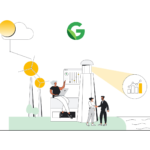How to Get Suppliers to Participate in Scope 3 Data Collection: A Step-by-Step Guide
If you’ve already watched our video, “5 Scope 3 Mistakes Sustainability Teams Keep Making (and how to fix them)”, you know that oversimplifying your supply chain is one of the biggest barriers to credible Scope 3 reporting.
And at the heart of that problem?
Getting suppliers to actually participate in Scope 3 data collection!
It’s not easy. Suppliers are stretched thin. Data collection feels burdensome. And unless you’re one of their biggest customers, your requests might fall to the bottom of the priority pile. Truth be told, they are probably feeling the same pressures and challenges when it comes to scope 3 that you are!
But here’s the good news:
Supplier engagement is a skill—and like any skill, it can be learned, systematized, and scaled.
In this guide, we’ll walk you through a step-by-step approach you can start using today to move beyond industry averages and start getting meaningful Scope 3 data from your supply chain.
Step 1: Get Clear on What You Need (Before You Ask)
Before you reach out to a single supplier, define:
- What data you need (e.g., product-level emissions? facility-level emissions?)
- Which standards you’re aligning to (e.g., GHG Protocol, CDP Supply Chain)
- What format you want it in (spreadsheets, CDP questionnaires, internal surveys?)
- Why it matters (what’s the impact if you don’t get it?)
🎯 Pro Tip: Keep it simple.
Request only what you absolutely need at this stage. Complex or unclear asks = no response.
Step 2: Segment Your Suppliers by Priority
Not all suppliers are created equal for Scope 3 reporting. Focus your engagement where it matters most.
Create a simple segmentation:
- Tier 1: Largest emissions impact + strategic relationship
- Tier 2: Moderate emissions impact
- Tier 3: Minimal impact suppliers
🎯 Pro Tip: Start with Tier 1.
Even securing data from your top 10-20 suppliers can significantly improve your Scope 3 accuracy.
Step 3: Build the Case Before You Make the Ask
Suppliers need to know:
- What’s in it for them (reduced risk, preferred supplier status, staying ahead of regulation)
- That you’re serious (part of your ESG program, not just “checking a box”)
- That help is available (templates, training, support)
Your communication should position this as a partnership, not a compliance exercise.
Step 4: Provide Tools and Templates to Make It Easy
The easier you make it for suppliers, the more likely they are to respond.
Offer:
- Links to Green Quarter ESG. Your go to, FREE, ESG resource hub!
- Pre-built data request templates
- Links to free calculation tools (e.g., GHG Protocol Calculation Tools)
- A simple guide explaining Scope 3 and why you’re asking
🎯 Pro Tip: Don’t assume they understand ESG jargon.
Use plain language and provide examples wherever possible.
Step 5: Set Clear Deadlines and Follow Up Respectfully
Your initial outreach should include:
- A clear deadline (2-4 weeks is typical)
- Instructions on how to submit data
- A contact person for questions
And then—follow up!!! Suppliers are busy. A polite, professional reminder 1-2 weeks before the deadline is critical.
🎯 Pro Tip:
Frame follow-ups as support, not pressure. Example:
“Just checking if you need any additional help to complete the emissions data request—we’re happy to assist!”
Step 6: Recognize Participation and Share Wins
Suppliers love being recognized—especially when it ties into innovation, leadership, or market trends.
Ideas to incentivize participation:
- Create a “Sustainability Leader” badge for suppliers
- Offer public recognition (with permission) in sustainability reports
- Make Scope 3 engagement part of supplier performance reviews or future contract discussions
🎯 Pro Tip:
Recognition works better than punishment—especially when ESG regulations for supply chains are still evolving.
Bonus: Embed It into Supplier Relationships Long-Term
Once you have your first wave of data, don’t stop.
Make Scope 3 engagement part of:
- New supplier onboarding
- Annual supplier evaluations
- Ongoing training and education programs
🎯 Pro Tip:
Formalize Scope 3 data expectations in contracts and procurement policies moving forward. This reduces the need for constant chasing down the line.
Final Thoughts
Getting suppliers to participate in Scope 3 data collection is about building relationships, simplifying the process, and showing them it matters rather than just shouting louder!
Even small wins—like getting better data from a handful of high-impact suppliers—can significantly move the needle on your ESG reporting and credibility.
Ready to start?
Download our free Scope 3 Supplier Engagement Toolkit for ready-to-go templates, communication guides, and survey examples you can customize for your organization.


